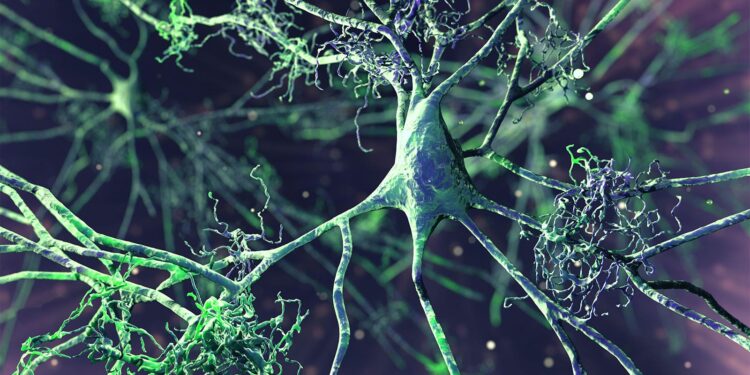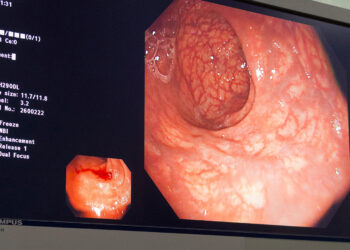In early 2024, we reported new research that suggested Alzheimer’s disease may be transmissible under rare conditions. The study fueled debates in the Alzheimer’s research community, which we discuss in this follow-up story.
Five U.K. patients treated with human growth hormone from cadaveric pituitary glands when they were children later developed early dementia or other changes consistent with Alzheimer’s disease, John Collinge, MD, of University College London, and co-authors said in Nature Medicine in January 2024.
Four of these patients were between ages 38 and 49 when their cognitive symptoms started; the fifth was 55. Two had biomarker changes that supported a possible Alzheimer’s diagnosis. Two did not have molecular biomarker testing but showed progressive brain atrophy on imaging. One had Alzheimer’s pathology detected at autopsy.
The findings did not mean that Alzheimer’s could be transmitted between people during daily activities or routine medical care, Collinge emphasized. “The patients we have described were given a specific and long-discontinued medical treatment, which involved injecting patients with material now known to have been contaminated with disease-related proteins,” he stated when the study was published.
“However, the recognition of transmission of amyloid-beta pathology in these rare situations should lead us to review measures to prevent accidental transmission via other medical or surgical procedures, in order to prevent such cases occurring in the future,” he said.
Was This Alzheimer’s Disease?
The findings fueled discussions almost immediately on the global networking website AlzForum. Several experts said it seemed likely that Alzheimer’s pathology could be transmitted iatrogenically.
Six months later, a group of researchers including neurologist Avindra Nath, MD, of the National Institute of Neurological Disorders and Stroke, published a perspective article in Alzheimer’s & Dementia stating that the cases did not provide evidence that Alzheimer’s disease was transmitted by cadaveric growth hormone.
“Contrary to the title of the paper that suggests that these patients developed Alzheimer’s disease, a description of the patients and their findings suggests that most of them did not meet criteria for Alzheimer’s,” Nath said.
“Each individual had different clinical manifestations and course of illness,” he told MedPage Today.
“There were alternative explanations for their clinical findings, and they lacked laboratory support of Alzheimer’s disease, except for one individual,” Nath continued. “And the presence of Alzheimer’s-like pathology in a single individual could very well be by chance alone.”
The presentations of the cases were highly variable and not consistent clinically or pathologically with probable or definite Alzheimer’s disease, Nath and co-authors argued.
“In people with progressive cognitive decline, the diagnosis of Alzheimer’s disease requires a demonstration of amyloid and tau pathology, or amyloid and tau biomarkers,” they wrote. “Extensive tau pathology is not demonstrated, and some also lack amyloid beta pathology.”
“If the findings of this paper were to be correct, it would have important public health ramifications,” Nath noted. “Hence, it is critical that there be a high bar for making such conclusions.”
Surveillance Continues
More than 50 years ago, pioneering studies showed that neurodegenerative diseases like kuru and Creutzfeldt-Jakob disease were transmissible. In 1982, Stanley Prusiner, MD, of the University of California San Francisco, demonstrated that a single misfolded protein, or prion, was sufficient to do so. Prusiner later received the Nobel Prize in Physiology or Medicine for this work.
Since then, there’s been growing concern that other neurodegenerative diseases could be transmitted, Nath said.
“There have been several studies in which there has been iatrogenic transmission of Creutzfeldt-Jakob disease by exposure to brain tissue,” he observed.
Between 1959 and 1985, cadaver-derived human growth hormone was used around the world to treat young patients for pituitary insufficiency. The product was withdrawn after some patients received prion-contaminated cadaveric growth hormone and subsequently died of Creutzfeldt-Jakob disease.
In 2015, Collinge and co-authors reported that some of the U.K. patients who died of iatrogenic Creutzfeldt-Jakob disease had amyloid-beta pathology at autopsy. Whether they also had Alzheimer’s symptoms wasn’t known because Creutzfeldt-Jakob, a universally fatal prion disease that progresses rapidly, may have masked any symptoms.
In the U.S., nearly 7,700 children were treated with pituitary human growth hormone under the National Hormone and Pituitary Program (NHPP) from 1963 to 1985. In 1977, the NHPP started a safer purification method and later fully switched to recombinant human growth hormone.
“The NIH in collaboration with the CDC has been overseeing the surveillance of the approximately 7,700 individuals who received cadaveric human growth hormone in the United States in the 1960s, 1970s, and early 1980s through the NHPP,” Nath said. “We are currently evaluating all deaths in the NHPP cohort — 1,480 to date — to determine whether there is a signal for an increase in Alzheimer’s disease.”
The cohort also is being monitored for other neurodegenerative diseases, he added. To date, there’s been no conclusive evidence for other diseases except possible cerebral amyloid angiopathy, he said.
Despite the questions raised by Nath and colleagues, Collinge maintains that his 2024 paper is sound. “With the greatest of respect to these authors, we are describing a new condition, iatrogenic Alzheimer’s disease,” he told MedPage Today.
“Just as iatrogenic Creutzfeldt-Jakob disease has different clinical and pathologic features to sporadic Creutzfeldt-Jakob disease, we would expect differences with classical Alzheimer’s disease,” Collinge said. “The full phenotypic range of iatrogenic Alzheimer’s disease — which has an acquired, rather than sporadic, etiology — will emerge and be better understood as more cases are reported.”
Source link : https://www.medpagetoday.com/neurology/alzheimersdisease/113634
Author :
Publish date : 2025-01-03 16:30:00
Copyright for syndicated content belongs to the linked Source.














